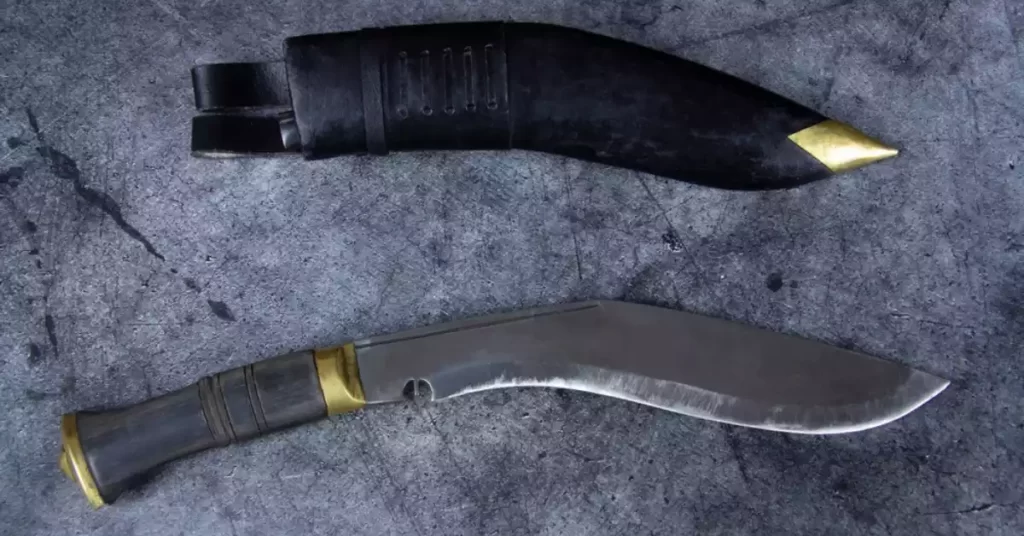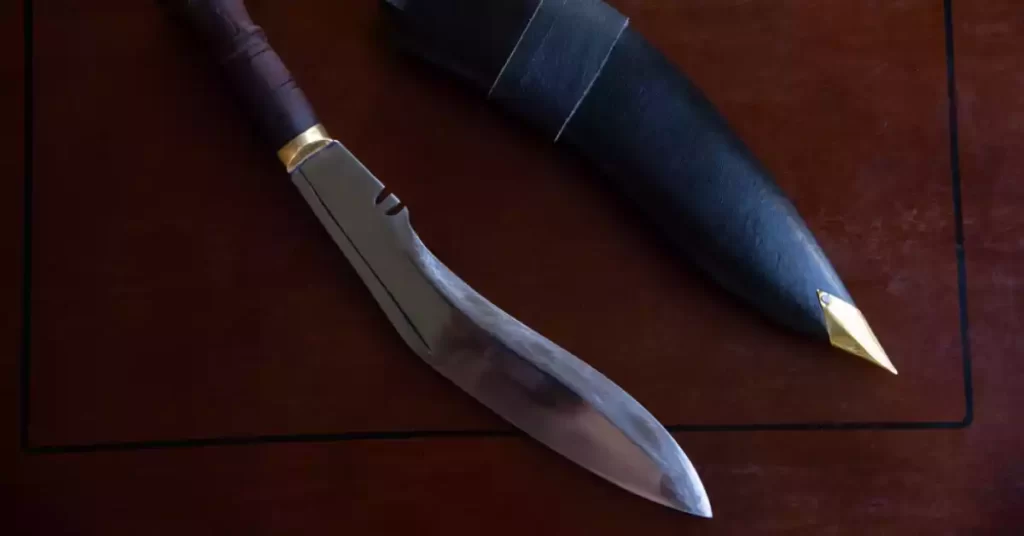A distinctive weapon with a rich cultural history, the kukri is a knife that has captivated enthusiasts worldwide. This curved blade, originating from the heart of the Himalayas, is the national weapon of Nepal. For hundreds of years, it has been an integral part of the lives of Nepalese people, serving as both a tool and a weapon.
The key feature of the kukri is its unique notch. This small detail may seem insignificant, but it carries a depth of practical and symbolic meaning. The notch, known as the ‘kauda’ or ‘cho’, distinguishes the kukri from many other blade designs.
In a nutshell, the kukri’s notch embodies the balance of aesthetics, function, and symbolism. Its relevance extends far beyond its physical form, adding layers of cultural significance and practicality to this iconic knife.
The Notch in Detail
Physical Description
Diving into the details, the kukri’s notch is an angular cut situated near the handle of the knife. While the overall design of the kukri varies, the notch remains a consistent feature. It takes the shape of a crescent or a semi-circle, sometimes resembling religious symbols.
Cultural Significance
The kukri’s notch has deep cultural roots in Nepalese society. Some associate it with symbols of Hindu deities like Shiva and Kali. Others see it as a representation of a cow’s foot, a sacred animal in Hindu culture. Regardless of interpretation, the notch holds a spiritual resonance, echoing the intertwined nature of culture and utility in Nepalese society.

Purpose of the Notch
Practical Uses
When it comes to functionality, the notch on a kukri is far from decorative. It prevents the user’s hand from slipping onto the blade during use, ensuring safe handling of the weapon. Moreover, the notch also serves to catch and neutralize an opponent’s blade in combat situations.
Symbolic Meanings
Symbolically, the notch amplifies the kukri’s cultural depth. The association with Hindu deities imbues the knife with a sense of power and respect. Moreover, the representation of the cow’s foot embodies gentleness and fertility, contributing to the blade’s sacred aura.
Debates about the Notch
Controversial Theories
Though the function and symbolism of the notch are widely accepted, they’re not without controversy. Some theories suggest the notch serves as a blood drip, preventing the handle from getting slippery during battle. However, these theories lack historical evidence and often get debated among scholars and enthusiasts.
Modern Interpretations
Modern kukri manufacturers sometimes alter the notch design for aesthetic or functional reasons, leading to different interpretations. While the traditional symbolism may not hold for these variations, they offer fresh perspectives on the kukri’s iconic feature.

The Notch in Modern Kukris
Variations in Design
Contemporary kukris often showcase a variety of notch designs, ranging from simple curves to elaborate symbols. These variations reflect the evolving tastes and preferences of users worldwide, highlighting the kukri’s enduring appeal.
Role in Contemporary Use
Despite changes in design, the notch’s functional purpose remains essential. Whether in modern warfare, outdoor activities, or martial arts, the notch contributes to the kukri’s effective and safe use.
Comparison with Other Knives
Similar Features in Other Blades
Some other knife designs, like the Bowie knife or the Nepalese khukuri, also incorporate notches or guards near the handle. These elements provide similar practical benefits, like improved safety and blade control.
Unique Aspects of the Kukri Notch
What sets the kukri’s notch apart is its cultural symbolism. Few other knife designs carry such a potent blend of functional and symbolic elements, making the kukri’s notch truly unique.

Frequently Asked Questions
What does the notch on a kukri symbolize?
The notch on a kukri, known as the ‘kauda’ or ‘cho’, is often associated with Hindu deities or the foot of a cow, which is a sacred animal in Hindu culture. However, interpretations vary, and some modern versions may not hold the same symbolic meaning.
Does the kukri’s notch serve a practical purpose?
Yes, the notch serves a practical purpose. It prevents the user’s hand from slipping onto the blade, ensuring safe handling. Some also believe that it can catch and neutralize an opponent’s blade in combat.
Are there variations in the notch design on modern kukris?
Yes, modern kukris showcase a variety of notch designs, reflecting evolving tastes and preferences. While these variations might alter the traditional symbolism, they maintain the notch’s practical functions.
Conclusion
A closer look at the kukri’s notch reveals the multifaceted nature of this fascinating blade. Beyond the sharp edge and iconic curve, it’s the small, seemingly insignificant details that often hold the most profound meanings. The notch stands as a testament to this, reflecting the intricate relationship between form, function, and cultural symbolism in traditional weaponry.
While the kukri’s design may evolve with changing times, the notch remains a defining feature. As we embrace these changes, we must also appreciate the rich historical and cultural heritage embodied in this small but significant element. In the end, understanding the kukri’s notch brings us closer to comprehending the deeper essence of this remarkable weapon.
